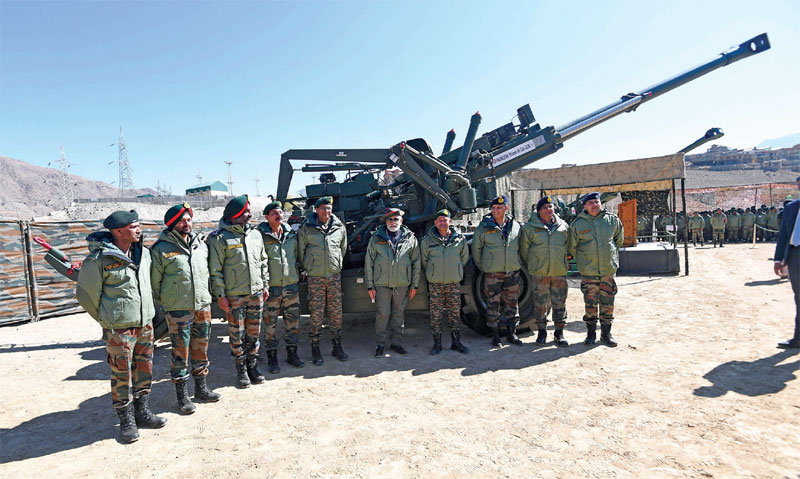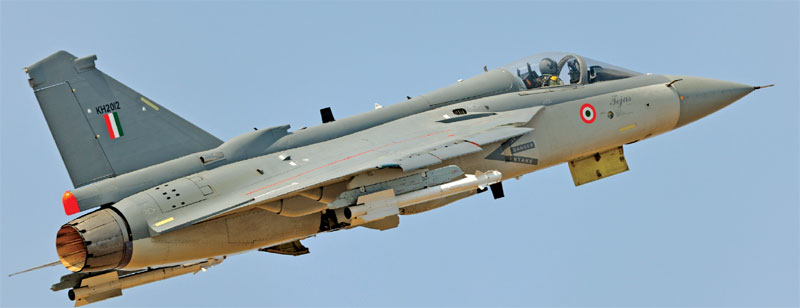The budget suggests that government is not taking defence preparedness seriously
 Air Cmde K.A. Muthana (retd)
Air Cmde K.A. Muthana (retd)
The allocation for defence in the union budget for 2023-24 seems to cater mostly to committed liabilities. The defence minister also stated during Aero India 2023 that 75 per cent of the capital expenditure would be for purchases from domestic agencies. While nobody can deny the wisdom of being self-reliant, the way one goes about implementing policies and ensuring safeguards is important.
At the same time, indulging in wasteful expenditure and forcing on the armed forces equipment that is not suitable for future warfare is disappointing. While stating that this is not the time for war, the government does not seem to trust the armed forces to do what is right. It also does not seem to want to understand the hardware needs of future warfare. After reportedly clearing the release of Rs 6,500 crore for a lemon called LCA Mk 2, it allows unveiling to the whole world of a similar weight class of aircraft called the HLFT-42 by the same public sector manufacturer.
Fortunately, Lord Hanuman grabbed most of the attention. If it is a supersonic trainer in that class that is desired, then the LCA trainer already exists. What actually will be required is a replacement in the next decade for Hawk aircraft by an aircraft of the USAF T-7 Red Hawk class. For, as long as manned aviation continues to exist, contemporary trainer aircraft will be required. While the departments in the ministry of defence continue to meander incoherently, some other agencies in the national security apparatus seem to be doing things right, especially in preparing for non-kinetic aspects of warfare.
Quantum Onslaught
In future, the single biggest threat to our national defence will come from China’s use of quantum technologies. China is in the process of weaponising quantum computing and claims to have already developed a superconducting quantum processor. While such claims of quantum supremacy may well be part of cognitive warfare, if true, it will be capable of breaking the encryption standards of our security systems, financial systems, governance systems etc., thus plunging the country into chaos. Even block chains will be vulnerable.

The use of offensive quantum technologies will be all pervasive across cognitive, non-kinetic and kinetic warfare. Quantum radar may be able to see through stealth, while quantum metrology would offer un-jammable navigation platforms. Likewise, quantum electronic warfare will render our electronic warfare systems obsolete. Therefore, investing and succeeding in the development of quantum technology systems protected by post-quantum cryptography will make our systems inherently secure and uncrackable. Towards this aim, the recent formation of the Indo-US quantum co-ordination mechanism is a welcome step as Post Quantum Encryption (PQE) remains a top priority for the National Security Agency (USA) also. The IAF must prepare to adopt quantum technologies as soon as they become available. This will require elaborate planning and resource allocation.
Stratosphere Security
Today, security of the Indian air space in the mid to higher stratosphere has to become a relevant topic for discussion. Balloons or pseudo satellites could squat in this part of the atmosphere for months together, gathering intelligence or engaging in even more belligerent forms of non-kinetic warfare. While there may be enough memes in the social media on the F-22 bringing down a balloon, we need to ponder on our own ability to detect, let alone bring down such aircraft that are more suitable for certain non-kinetic warfare purposes than any other.
The Chinese balloon over the US was at about 58,000 feet. The F-22 has a service ceiling of 65,000 feet and was armed with the AIM-9X air-to-air missile, which has an imaging seeker. Hence the choice of the weapon system. IAF fighters with the highest service ceiling can go up to 56,000 feet. It will be a very interesting exercise to try and bring down a spy aircraft squatting at, say 70,000 feet. The possible means can be kinetic or physical-non-kinetic (directed energy weapon).
Legally, it should be no issue as the upper limit of our sovereign airspace is defined as ‘unlimited’. But, the intent, command, control, procedures and the means to detect and bring down such hostile aircraft must be laid down and trials carried out. The sooner this is done the better because the process will be time consuming. A big collateral benefit will be that our own High Altitude Pseudo Satellite (HAPS) programme will get a boost since a target will be required.
Satellite Aircraft
One of the finest innovations by Ukraine and its allies is the use of the Starlink constellation of satellites to overcome a facet of Russian non-kinetic onslaught. There was safety in numbers as the Russians found it impossible to jam thousands of satellites that are in orbit even though they were un-hardened when the war began. It is safe to assume that once the department of defence realised the potential, they will have assisted in hardening the constellation.
In the doctrine of the IAF, IAP 2000-22, while the aspiration to be an aerospace power has been abundantly expressed, the intention to be a launcher of space vehicles into LEO has not been expressed. The IAF must give itself the responsibility and acquire the ability to launch cube sats/disc sats of up to 50 kg from SU-30 aircraft into orbits at about 250 km, and slightly bigger satellites into higher LEO from jet powered transport aircraft. The advantages are significant. The highest cost of launch is from the first stage booster.
Even the new Small Satellite Launch Vehicle (SSLV) lifts 120 tons to place in orbit a maximum of 550 kg payload, never to return. Such costs can be mitigated significantly. Launches can be from close to the equator, which can help to either reduce launch rocket weight or increase payload. A launch on demand will be possible especially for replacements or enhancement in numbers during hostilities. Repeated launches in a day will be possible. Although making the SSLV operational is a good step by ISRO, a launch capability from an aircraft can be a useful force multiplier and also cement the place of the IAF as a significant player in space activities. The HAL has held some initial discussions with the ISRO for possible enabling of launch from Su-30 aircraft.

Strategic Bombing
The doctrine of the IAF also talks about strategic bombing operations but the IAF has no means to execute such operations against centre of gravity targets in China. And these targets are not in Tibet. It is absurd to even contemplate air-to-air refuelling deep inside enemy territory to extend the range of fighter aircraft. Even if the IAF manages to acquire long range air launched cruise missiles, aircraft would have to penetrate at least 1,000 km into enemy territory before centre of gravity targets come within range. So, the IAF must lease and operate long range stealthy bombers, like the navy does with nuclear submarines, in order to acquire an ability required by the doctrine. This is while China already operates the largest bomber fleet in the world and plans to increase it by at least 25 per cent in the next decade. While the present ones are the legacy H-6, the additions will be the stealthy H-20.
Inappropriate Platform
After years of refusing to acknowledge the existence of the single engine 16.5T LCA Mk 2 oxymoron, the IAF leadership in the middle of 2022 suddenly started talking about the possible induction of this aircraft later this decade. It is a no brainer to deduce where the pressure has come from because it happened soon after the CCS cleared further funding.
From the perspective of having an offensive air capability, the most urgent requirement of the IAF is to have a stealthy aircraft, i.e., the twin engine AMCA. Generally, the same set of working level designers have to attend to LCA Mk1A, LCA Mk2, AMCA and the Twin Engine Deck Based Fighter (TEDBF). This makes them focus on the programme that is in crisis at any point of time. Crises may vary from design issues to upcoming review meetings. As has been happening thus far, all programmes get delayed including the AMCA.
There are reasons why all next generation aircraft are twin engine, be it American, European, Turkish, Chinese, Taiwanese, South Korean or Japanese. While a single engine aircraft may have a better instantaneous turn rate, a twin engine aircraft can be expected to have a better sustained turn rate, sustained high ‘g’ capability and significantly, more specific excess power needed to carry very large payloads like hypersonic weapons. The ability to carry large payloads is not the same as carrying a large number of missiles. For example, it has been touted that the LCA Mk2 can carry eight BVR missiles. For this to be practicable, the entire BVR missile inventory of the IAF would have to be given to two or three LCA Mk2 squadrons.

One of the most critical design features of a fighter aircraft is the power generation and thermal absorption capacity. The single engine F-35 is facing issues. Its F135 engine was optimised to absorb up to 14 kW of waste heat from the electronics. But the present version already produces 30 kW and this is expected to grow to 47 kW with planned upgrades. Such power offtakes have serious consequences to engine life and available propulsive power. At least the Americans have an option and have planned to change to new technology three stream adaptive cycle engines. We are still negotiating for core engine technology transfer of legacy two stream engines. The least we can do is to put two of them on the next platform. Serious power requirements will arise from directed energy and other non-kinetic forms of warfare in the next decade.
The single engine LCA Mk2 has been designed with an incremental mentality. Since it is an incremental aircraft over the Mk 1/1A, designers have found it inconvenient to reengineer and resolve many inadequacies. Any aviation professional will tell you that an Auxiliary Power Unit (APU) is a huge operational and maintenance force multiplier. Most fighters’ worth mentioning of the last century are equipped with APUs. Our next one will not be.
The optimal path would have been to create a capability around a twin engine core and wrap around it one airframe suitable for the AMCA and another for the TEDBF. Brahmos Aerospace has done such optimisation for land, sea, air and coastal battery versions.
Good Management
The IAF can only focus on good management of allotted resources and engage in small ticket value addition. While nudging resource allocators to make rational decisions, whether they are being listened to or not is anybody’s guess. Decision makers have to be reasonably technology savvy and be agile in adapting to emerging situations irrespective of previous decisions made with previous knowledge. Bombastic announcements and sloganeering may impress domestic audiences, but adversarial forces and potential export customers will only snigger. Years down the line there will be small headlines like, ‘LCA export prospects to Malaysia has had a “slight” setback’, and nobody will be the wiser.

